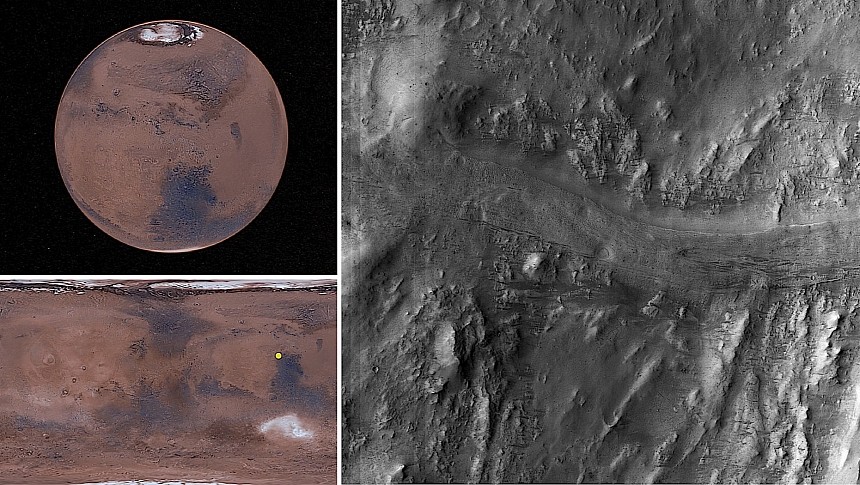We're probably still a long way from the time when we'll be able to call planet Mars home, and see its surface dotted with cities connected by road, rail, or who knows what else. But for the dreamers among us, even the present-day day features of the Red Planet, as seen through our primitive hardware, can be a glimpse into both its past and future.
Said dreamers will see in this image of Mars the remnants of some sort of ancient local road, and possibly a perfect site to build the roads of the future there. It actually shows a rier bed that snakes its way over the northwestern edge of the Antoniadi Crater, seemingly going from east to west in this pic, now carrying no water, but at one point possibly even teeming with life.
Named after a French astronomer, the Antoniadi Crater sits on the Syrtis Major Planum in the northern and western hemispheres of the planet. It is the result of one of the countless asteroid strikes Mars suffered over the ages, an impact so powerful it left a scar on the planet's surface that is almost 400 km (248 km) across.
Like many other places up there, it's believed Antoniadi was once home to many rivers and lakes. Common sense would tell you the water that flowed and glittered under the Sun there dug its way into the ground, and its passing will be forever inscribed in the planet's surface as valleys and such.
But, despite being caused by a river, what we see in this photo shows the exact opposite of a river valley, and is in turn a raised geographical feature that should not have been caused by flowing water at all.
Astronomers know of this phenomenon happening all over the surface of Mars. Despite the action of water, the deposition of rocks and cementation made these places hard to erode by the elements. In the eons that have passed since water's disappearance, everything around them was eaten away, leaving former fluvial ridges such as these more visible than anything else around them.
To date, despite the several missions we humans sent to Mars, none of them targeted the Antoniadi Crater. The picture you're looking at was snapped by the HiRISE orbital camera in November 2021, from an altitude of 280 km (174 miles).
It is one of the tens of thousands of photographs of the Martian surface the Mars Reconnaissance Orbiter (MRO) instrument sent back since it arrived there back in 2006. It may not look as spectacular as many of the others we've seen over the years, but like all of them, it will eventually help us paint a clearer picture of the place that haunts the dreams of so many.
Named after a French astronomer, the Antoniadi Crater sits on the Syrtis Major Planum in the northern and western hemispheres of the planet. It is the result of one of the countless asteroid strikes Mars suffered over the ages, an impact so powerful it left a scar on the planet's surface that is almost 400 km (248 km) across.
Like many other places up there, it's believed Antoniadi was once home to many rivers and lakes. Common sense would tell you the water that flowed and glittered under the Sun there dug its way into the ground, and its passing will be forever inscribed in the planet's surface as valleys and such.
But, despite being caused by a river, what we see in this photo shows the exact opposite of a river valley, and is in turn a raised geographical feature that should not have been caused by flowing water at all.
Astronomers know of this phenomenon happening all over the surface of Mars. Despite the action of water, the deposition of rocks and cementation made these places hard to erode by the elements. In the eons that have passed since water's disappearance, everything around them was eaten away, leaving former fluvial ridges such as these more visible than anything else around them.
To date, despite the several missions we humans sent to Mars, none of them targeted the Antoniadi Crater. The picture you're looking at was snapped by the HiRISE orbital camera in November 2021, from an altitude of 280 km (174 miles).
It is one of the tens of thousands of photographs of the Martian surface the Mars Reconnaissance Orbiter (MRO) instrument sent back since it arrived there back in 2006. It may not look as spectacular as many of the others we've seen over the years, but like all of them, it will eventually help us paint a clearer picture of the place that haunts the dreams of so many.







